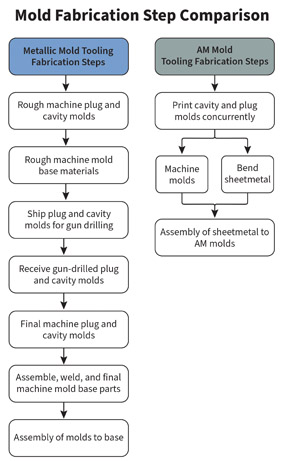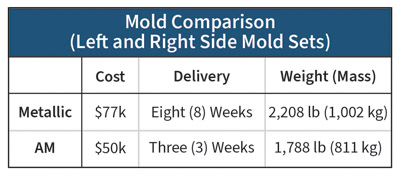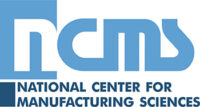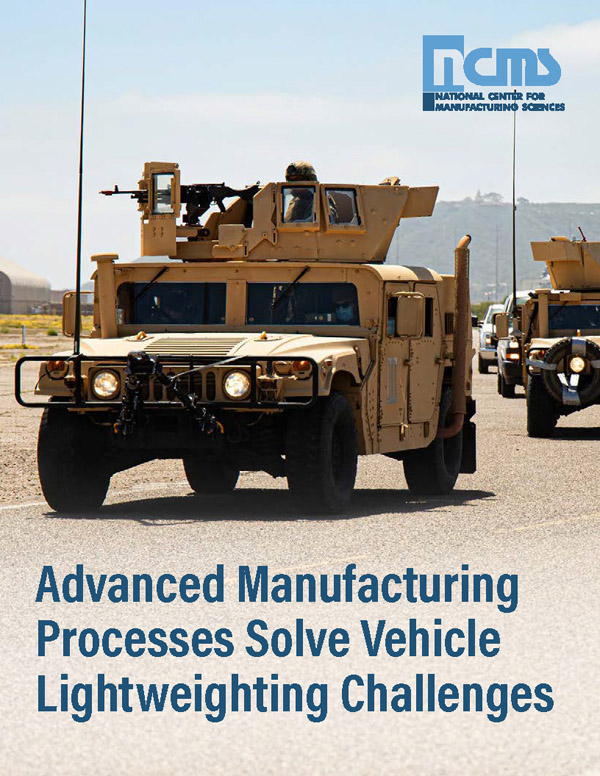NCMS Technology Briefs highlight NCMS’s cultivation and growth of innovative technologies. Through our management of government and industry collaborations, we’ve gained insights into novel approaches and best practices that can assist all companies to navigate the sometimes complex journey toward advancement. Based on the results of NCMS technology projects, the briefs show the applicability and usefulness of proven technical advances—all in an effort to speed adoption and eliminate duplication of effort. NCMS is pleased to share these insights to support U.S. manufacturing competitiveness.
View Full PDF
Introduction
Recently, the National Highway Traffic Safety Administration (NHTSA) finalized new Corporate Average Fuel Economy (CAFE) Standards for 2027-31 model year vehicles sold in the United States. The new standards require an industry-wide fleet average of approximately 50.4 miles per gallon (mpg) by model year 2031 for passenger cars and light trucks. Vehicle lightweighting is essential for the automotive industry to meet these standards, as lighter vehicles require less energy to accelerate and maintain speed, so they consume less fuel.
To reduce the overall weight of ground vehicles, components traditionally made with steel and other heavy alloys must be replaced with lighter weight materials such as carbon fiber and polymer composites. While not all components can be lightweighted, even a 10 percent reduction in vehicle weight can result in a 6 to 8 percent fuel economy improvement. The US Department of Energy’s Vehicle Technology Office estimates that using lightweight components and high-efficiency engines enabled by advanced materials in one quarter of the US fleet could save more than 5 billion gallons of fuel annually by 2030.
Composite materials are now widely used in automotive structural components to significantly reduce weight without compromising durability. Along with better fuel economy and lower emissions, using composite materials for body components has many benefits over metallic components including toughness, thermal insulation, corrosion resistance, and more. Despite the known benefits of lightweight composite materials, these materials have some barriers to widespread implementation including raw material costs, manufacturing and maintenance costs, and flammability, smoke, and toxicity (FST) concerns.
But successes in advanced manufacturing processes have addressed many of these barriers. Recently, a recent National Center for Manufacturing Sciences (NCMS) initiative has helped accelerate the use of thermoplastic composite materials in the commercial automotive industry. The initiative brought together a team of experts from the US Army Ground Vehicle Systems Center (GVSC) and the University of Maine’s Advanced Structures and Composites Center (ASCC) to validate that lower cost, safer, and more durable composite components could be developed for the high mobility multipurpose wheeled vehicle (HMMWV). The team produced a thermoplastic composite cargo shell that is 36 percent lighter than the original metallic component and a composite floating crew vehicle floor that is 55 percent lighter than the original metallic floor.
While these components were created for a military vehicle, the methods employed by this initiative have direct application to the commercial automotive industry. For the past five decades, the automotive industry has devoted significant work across the global automotive composites supply chain on trying to make thermoplastic composites a viable option for horizontal body panels with a Class A finish, including hoods, roofs, and trunk lids. This NCMS initiative made progress on solving two challenges the automotive industry faces with thermoplastic components: (1) improving the mechanical integrity of thermoplastic components at elevated temperatures, and (2) optimizing the manufacturing process for thermoplastic vehicle components.
Durability Testing on Thermoplastic Composite Degradation
The automotive industry uses both thermoset and thermoplastic matrix composites. Thermoplastics are generally more environmentally friendly because they are more recyclable and can be repurposed more easily for other applications. However, the property that makes thermoplastic composites easier to recycle can also compromise their long-term mechanical integrity at elevated temperatures. This is mitigated by switching from short/discontinuous fiber reinforcement to continuous fiber options. The inclusion of continuous fiber into thermoplastic composites has facilitated their use in structural applications.
For the NCMS project, researchers sought to determine the most effective material for the composite cargo shells and vehicle floors. They performed durability testing as well as flammability, smoke, and toxicity (FST) testing according to relevant standards developed by the American Society for Testing and Materials (ASTM) International. Vertical burn tests were conducted according to ASTM D3801, smoke density testing was conducted according to ASTM E662, surface flammability was assessed according to ASTM E162, and heat and visible smoke was observed according to ASTM E1354. After testing of material coupons and finite element analysis (FEA) of the vehicle structures, the researchers determined that carbon fiber reinforced polyphenylene sulfide (PPS) was the best fit for manufacturing the cargo shells.
For the composite crew floor, the team selected carbon- and glass-fiber reinforced PPS. This is because, due to the severe operating environment of a combat vehicle, the crew floor would need to be tolerant of extreme dynamic loads (mobility + blast), varying thermal loads (from arctic to desert climates), as well as resistant to FST. For the composite crew floor, the geometry was optimized to minimize mass of the floor while limiting total dynamic deflection, thus ensuring that the floor would not contact the surrounding vehicle structure during a blast event. The floor’s optimized design utilized overlapping geometric features which increased the overall floor stiffness without the need for increased material thickness.
Cost-Effective Manufacturing of Thermoplastic Composite Components
In addition to FST and environmental degradation challenges, one of the most prominent hurdles to cost-effective composite manufacturing is the generally high cost of tooling that is used to form composite structural shapes. The dies, molds, and extrusion tools used in the manufacturing processes typically necessitate high-temperature-capable tooling that is expensive, both at a material level and at a fabrication level, and their construction requires long lead-times.
This initiative pioneered the use of low-temperature polymers for a set of molds that could be quickly produced via additive manufacturing (AM). A key technical development was the design and implementation of precision-formed metal cladding used to line the interior of the AM polymer molds, enabling them to withstand the high-temperature thermoplastic matrix composite. By combining the more readily available metal cladding process with lower-performance AM polymers, durable molds reduce cost and lower lead times.
When comparing the manufacturing steps of a typical metallic mold, numerous steps were saved by using the AM mold (see Figure 1).
The AM tooling approach was both faster and cheaper than a baseline metallic tool manufactured in parallel (see Figure 2). The team anticipates that at higher production volumes, costs would decrease even more.

Figure 1. Comparison of primary mold fabrication steps for (subtractive) metal molds and polymer AM molds
A significantly lower number of manufacturing steps are required for the AM molds which is part of their short lead-time compared to the metallic molds.
Source: “Utilizing Additive Manufacturing to Enable Low-Cost, Rapid Forming of High Temperature Lightweight Ground Vehicle Structures.” By David Erb, Benjamin Dwyer, Jonathan Roy, William Yori, Roberto A. Lopez-Anido, Andrew Smail, and Robert Hart. 2021 NDIA Ground Vehicle Systems Engineering and Technology Symposium. Survivability Technical Session. August 10-12, 2021. Accessed November 11. 2024. http://gvsets.ndia-mich.org/publication.php?documentID=829

Figure 2. Comparison of cost, fabrication time, and weight of metallic versus AM molds
Source: “Utilizing Additive Manufacturing to Enable Low-Cost, Rapid Forming of High Temperature Lightweight Ground Vehicle Structures.” By David Erb, Benjamin Dwyer, Jonathan Roy, William Yori, Roberto A. Lopez-Anido, Andrew Smail, and Robert Hart. 2021 NDIA Ground Vehicle Systems Engineering and Technology Symposium. Survivability Technical Session. August 10-12, 2021. Accessed November 11. 2024. http://gvsets.ndia-mich.org/publication.php?documentID=829
Results and Public Benefits
The use of carbon fiber reinforced PPS to manufacture the composite cargo shells reduced the weight by 36 percent while meeting structural and FST requirements. For the crew floor, using carbon- and glass-fiber reinforced PPS lowered weight by 55 percent while remaining nearly cost-neutral in raw material cost compared to a baseline machined aluminum floor. Moreover, the sturdiness of the crew floor was validated under a simulated underbody blast event using finite element (FE) methods. Additionally, both thermoplastic composite components demonstrated fire retardant properties with strong resistance to UV radiation and high humidity (moisture-rich) operational environments.
The initiative’s production of high-temperature thermoplastic polymer composites with a reinforced low-temperature, AM polymer mold provides multiple advantages, which can help to achieve the following public benefits:
- Lower-cost and safer composite materials in commercial vehicles
- Lighter weight vehicles that consume less fuel and emit less greenhouse gases
- Reduced wear on roadways and bridges due to lower overall vehicle weights
- Reduced maintenance costs due to corrosion-free materials
- Improvement in quality and performance of vehicles
About NCMS
The National Center for Manufacturing Sciences (NCMS) is a cross-industry technology development consortium, dedicated to improving the competitiveness and strength of the US industrial base. As a member-based organization, it leverages its network of industry, government, and academic partners to develop, demonstrate, and transition innovative technologies efficiently, with less risk and lower cost.
NCMS enables world-class member companies to work effectively with other members on new opportunities—bringing together highly capable companies with providers and end users who need their innovations and technology solutions. NCMS members benefit from an accelerated progression of idea creation through execution.
Please note: All images in this publication, unless otherwise identified, are sourced through the DOD’s Defense Visual Information Distribution Service. Use of these images does not imply or constitute DOD endorsement.





